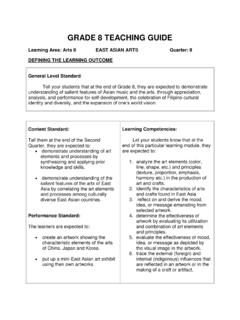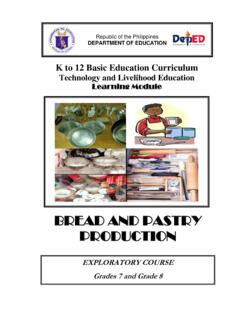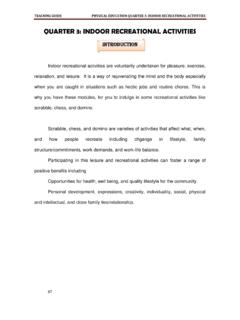Transcription of Technology and Livelihood Education Learning Module
1 K to 12 Basic Education Curriculum Technology and Livelihood Education Learning Module AGRICULTURAL CROP PRODUCTION EXPLORATORY COURSE Grades 7 and Grade 8 Republic of the Philippines DEPARTMENT OF Education AGRICULTURAL CROP PRODUCTION 1 K to 12 Technology and Livelihood Education TABLE OF CONTENTS What Is This Module About? .. 2 How Do You Use This Module ? .. 3 LESSON 1 Use Farm Tools and Equipment .. 4 - 28 LESSON 2 Perform Estimation and Basic Calculation .. 29 - 68 LESSON 3 Interpret Plans and Drawings .. 69 - 94 LESSON 4 Occupational Safety and Health .. 95 - 115 ANSWER KEYS .. 116 - 122 Acknowledgment ..123 AGRICULTURAL CROP PRODUCTION 2 K to 12 Technology and Livelihood Education Welcome to the world of Agricultural Crop Production! This Module is an exploratory course which leads you to Agricultural Crop Production National Certificate Level II ( NC II)1. It covers four common competencies that a Grade 7 / Grade 8 Technology and Livelihood Education (TLE) student like you ought to possess, namely: 1) Use farm tools and equipment; 2) Perform estimation and basic calculation; 3) Interpret plans and drawings; and 4) Apply safety measures in farm operations.
2 These four common competencies are covered separately in four Lessons. As shown below, each Lesson is directed to the attainment of one or two Learning outcomes: Lesson 1 Use Farm Tools and Equipment LO1. Select and Use Farm Tools LO 2. Select and Operate Farm Equipment LO 3. Perform Preventive Maintenance Lesson 2 Perform Estimation and Basic calculation LO 1. Perform Estimation LO 2. Perform Basic Workplace Calculations Lesson 3 Interpret Plans and Drawings LO1. Interpret Farm Plans and Lay-outs LO2. Interpret Irrigation Plan and Design Lesson 4 Apply Safety Measures in Farm Operations LO Appropriate Safety Measures while Working in the Farm LO 2 Safe keep / Dispose materials and outfit Your success in this exploratory course on Agricultural Crop Production is shown in your ability to perform the performance standards found in each Learning outcome. 1 NATIONAL CERTIFICATE (NC) is a certification issued to individuals who achieved all the required units of competency for a national qualification as defined under the Training Regulations.
3 NCs are aligned to specific levels within the PTQF. (TESDA Board Resolution No. 2004-13, Training Regulations Framework) NATIONAL CERTIFICATE LEVEL refers to the four (4) qualification levels defined in the Philippine TVET Qualifications Framework (PTQF) where the worker with: a. NC I performs a routine and predictable tasks; has little judgment; and, works under supervision; b. NC II performs prescribe range of functions involving known routines and procedures; has limited choice and complexity of functions, and has little accountability; What Is This Module About? AGRICULTURAL CROP PRODUCTION 3 K to 12 Technology and Livelihood Education This Module has 4 Lessons. Each Lesson has the following parts. Learning Outcomes Performance Standards Materials References Definition of Terms What Do You Already Know? What Do You Need to Know? How Much Have You Learned? How Do You Apply What You Learned? How Well Did You Perform?
4 To get the most from this Module , you need to do the following: 1. Begin by reading and understanding the Learning Outcome/s and Performance Standards. These tell you what you should know and be able to do at the end of this Module . 2. Find out what you already know by taking the Pretest then check your answer against the Answer Key. If you get 99 to 100% of the items correctly, you may proceed to the next Lesson. This means that you need not go through the Lesson because you already know what it is about. If you failed to get 99 to 100% correctly, go through the Lesson again and review especially those items which you failed to get. 3. Do the required Learning Activities. They begin with one or more Information Sheets. An Information Sheet contains important notes or basic information that you need to know. After reading the Information Sheet, test yourself on how much you learned by means of the Self-check.
5 Refer to the Answer Key for correction. Do not hesitate to go back to the Information Sheet when you do not get all test items correctly. This will ensure your mastery of basic information. 4. Demonstrate what you learned by doing what the Activity / Operation /Job Sheet directs you to do. 5. You must be able to apply what you have learned in another activity or in real life situation. 6. Accomplish the Scoring Rubrics for you to know how well you performed. Each Lesson also provides you with references and definition of key terms for your guide. They can be of great help. Use them fully.. \ How Do You Use This Module ? If you have questions, ask your teacher for assistance. AGRICULTURAL CROP PRODUCTION 4 K to 12 Technology and Livelihood Education Use Farm Tools and Equipment LESSON 1 LO 1. select and use farm tools; LO 2. select and operate farm equipment; and LO 3. perform preventive maintenance.
6 Learning OUTCOMES: At the end of this Lesson you are expected to do the following: AGRICULTURAL CROP PRODUCTION 5 K to 12 Technology and Livelihood Education Farm Equipment - These are machineries used in crop production. They are used in land preparation and in transporting farm inputs and products. These equipment need a highly skilled operator to use Farm implements - accessories pulled by animals or mounted to machineries to make the work easier Farm tools - objects that are usually light and are used without the help of animals and machines Preventive maintenance - an activity or operation done to prevent malfunction of tools and equipment and it is done to prolong the useful life of tools and equipment Repair - to restore to good condition something broken or damaged Definition of Terms AGRICULTURAL CROP PRODUCTION 6 K to 12 Technology and Livelihood Education Bolo Crowbar Pick-mattock Grab-hoe Spade Shovel Rake Spading fork Light hoe Hand trowel Hand cultivator Hand fork Pruning shears Axe Knife Sprinklers Water pails Sprayers Wheel barrow Sickle Plow Harrow Rotavator Materials/Resources Select and use farm tools Learning OUTCOME 1 Appropriate farm
7 Tools are identified according to use. Farm tools are checked for faults. Appropriate tools are safely used according to job requirements and manufacturers conditions. PERFORMANCE STANDARDS AGRICULTURAL CROP PRODUCTION 7 K to 12 Technology and Livelihood Education Read the questions carefully and select the best answer by writing only the letter of your choice on a separate sheet of paper. 1. Which of the following is an example of a digging tool? A. Bolo B. Crowbar C. Grub hoe D. Pruning shear 2. Which tool is used for cutting grasses? A. Shovel B. Bolo C. Crowbar D. Mattock 3. What tool does NOT belong to the group? A. Crowbar B. Mattock C. Shovel D. Pruning shear 4. Farm tools are very important in agricultural crop production because they _____ A. Make work easier B. Make work faster C. Save time and effort D. All of the above 5. A tool with one end of its blade flattened and the other pointed at right angles to its handle is a _____.
8 A. mattock B. crowbar C. bolo D. spade 6. Which tool resembles the appearance of spoon and use for transferring soil? A. Spade B. Shovel C. Spading fork D. Grub hoe What Do You Already Know? Pretest LO 1 Let us determine how much you already know about use of farm tools and equipment. Take this test. AGRICULTURAL CROP PRODUCTION 8 K to 12 Technology and Livelihood Education 7. What implement is being pulled by a working animal to till the land? A. Harrow B. Native plow C. disc plow D. disc harrow 8. An implement mounted to a tractor that is used to pulverize the newly plowed soil is a_____. A. trailer B. disc harrow C. native plow D. disc plow 9. An open container with a single wheel at the front and two handles at the back used to transport things A. Hand tractor B. Tractor C. Basket D. Wheel barrow 10. Which of the following tools is used to harvest crops? A. Knife B. Plow C. Spade D. Basket AGRICULTURAL CROP PRODUCTION 9 K to 12 Technology and Livelihood Education FARM TOOLS IN AGRICULTURAL CROP PRODUCTION Farm tools, implements, and equipment play very important role in agricultural crop production.
9 Their availability makes the work much easier and faster. However, even if one may have the most sophisticated tools and implements, but does not know how to use them, they are useless. In order to do crop production operations successfully, one must have a good working knowledge of the tools, implements and equipment before using them. Hand Tools Hand tools are usually light and are used without the help of animals or machines. They are being used in performing farm activities which involve small areas like school garden and home garden. Examples: Bolo is used for cutting tall grasses and weeds and chopping branches of trees. Crowbar is used for digging big holes and for digging out big stones and stumps. What Do You Need To Know? Information Sheet Read the Information Sheet very well then find out how much you can remember and how much you have learned by doing the Self-check AGRICULTURAL CROP PRODUCTION 10 K to 12 Technology and Livelihood Education Pick-mattock is used for digging canals, breaking hard topsoil and for digging up stones and tree stumps.
10 Grab-hoe is used for breaking hard topsoil and pulverizing soil. Spade is used for removing trash or soil, digging canals or ditches and mixing soil media. Shovel is used in removing trash, digging loose soil, moving soil from one place to another and for mixing soil media. Rake is used for cleaning the ground and leveling the topsoil. AGRICULTURAL CROP PRODUCTION 11 K to 12 Technology and Livelihood Education Spading fork is used for loosening the soil, digging out root crops and turning over the materials in a compost heap. Light hoe is used for loosening and leveling soil and digging out furrows for planting Hand trowel is used for loosening the soil around the growing plants and putting small amount of manure fertilizer in the soil. Hand cultivator is used for cultivating the garden plot by loosening the soil and removing weeds around the plant. Hand fork is used for inter row cultivation. Pruning shears is for cutting branches of planting materials and unnecessary branches of plants.









